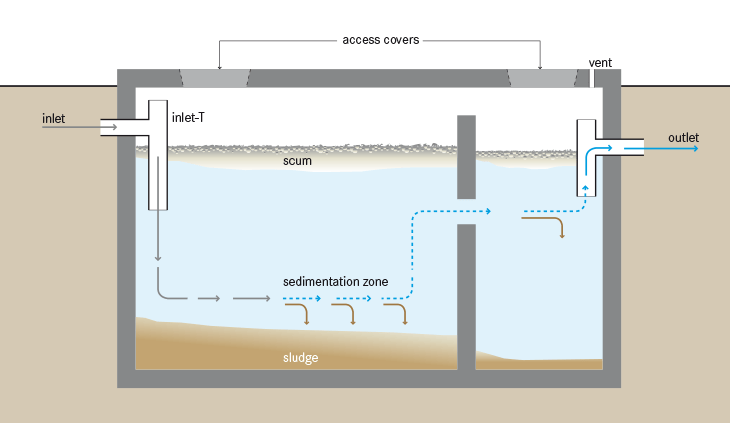What is a septic tank?
A septic tank is a tank typically placed underground, in which Settling and anaerobic processes reduce wastewater (solids and organics). Typically, septic tanks are made of concrete or are ready to install plastic tanks. Though their treatment efficiency is only moderate.
Septic tank systems are a type of simple onsite sewage facility.
Mistakenly, the term may be used to refer to a wastewater storage tank or a biodigester. These two are different and serve different purposes. A wastewater storage tank doesn’t treat the wastewater but only acts as a temporary hold before it is transported away. A bio-digester takes advantage of aerobic processes to more effectively break down the wastewater to give clean effluent.
Septic systems are also called:
- onsite wastewater treatment systems,
- decentralized wastewater treatment systems,
- cluster systems,
- on-lot systems,
- individual sewage disposal systems, and
- private sewage systems.
How it works.
Septic tanks usually comprise of one or two Large chambers depending on the needs of the people it serves.

The first chamber receives the wastewater and regulates its flow. The solid waste, being heavier, sinks to the bottom of the chamber. The liquid portion of the wastewater fills the first chamber until it reaches the inlet into the second chamber. The same happens in the second chamber until it fills the chamber. At the liquid then leaves the septic tank through an out let into a soak pit.
The fats and oils float on top of the liquid portion of the wastewater to form a layer of scum. The solid waste settles at the bottom of the septic tank’s chambers forming a sludge.
There are bacteria in the wastewater that anaerobically digest a portion of the waste. The rate of digestion is slow hence the sludge needs to be periodically emptied.
The soak pit is a covered, porous-walled chamber that allows water to slowly soak into the ground.
Considerations when choosing a septic tank
Size the system will occupy.
The size of the system is dependent on the number of people expected to use the system. Typically, the breakdown of wastewater in the septic tank is slow so it has to be dug deeper, than say a biodigester. Some may even be up to 7 meters deep.
Emptying the system.
The breakdown process is slow because the system only utilizes anaerobic processed, hence sludge usually accumulates in the tank.
Periodically the system will have to be emptied out using an exhauster or vacuum truck.
The soak pit.
The soil has to be able to soak up the liquid portion of the wastewater after the septic tank or stand the chance of saturating the nearby soil. This could form puddles of wastewater on the surface or in extreme cases collapse of the soak pit.
Why use a septic tank?
It might be your only option.
Many areas within Kenya, especially rural areas, do not have access to government provided wastewater treatment facilities. When faced with such a situation getting a septic tank to partially treat and hold waste water might be the only real option you have.
Public and environmental health.
Some more impoverished parts of the country that lack proper wastewater management systems resort to dumping their sewage, which is a huge public health and environmental risk. As a solution, one could use a septic tank to hold their wastewater.
What are my options?
When the local administration hasn’t provided a wastewater disposal solution your main options are a septic tank or an aerobic wastewater treatment system. The latter having its own advantages and considerations over a septic tank.




